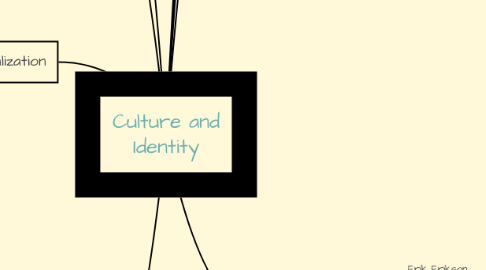
1. Socialization
1.1. Primary
1.1.1. Occurs from birth to adolesence
1.1.1.1. Influenced mostly by family
1.1.1.1.1. Intentional and unintentional
1.2. Secondary
1.2.1. Ongoing cycle through life
1.2.1.1. Learn through adjusting and new siuations
1.2.1.1.1. Differs from child socialzation
1.2.1.2. Marrying, New job, etc
1.3. Anticipatory
1.3.1. Previous experiences allows us to imagine new experiences
1.3.1.1. Mentally preparing for future roles
1.3.1.1.1. Education allows for this socialization
1.4. Resociliation
1.4.1. When people encounter new situations that involve learning new rules
1.4.1.1. Unique situations that people cannot rely on previous experiences to anticipate how to act
1.4.2. Jails, Government positions, etc
2. Agents of Socialization
2.1. School
2.1.1. Role Models
2.1.1.1. Passions
2.1.1.1.1. trial and error
2.2. Family
2.2.1. Role models
2.2.1.1. trial and error
2.2.1.1.1. experiances
2.3. Media
2.3.1. Role Models
2.3.1.1. passions
2.4. Peers
2.4.1. Experiances
2.4.1.1. explorations
2.4.1.1.1. trial and error
3. Every culture has its own expectations
3.1. Ex. Men are considered head of the house in Asian culture
4. Parenting
4.1. Culture
4.1.1. Learn from heritage
4.1.2. Religion
4.2. Identity
4.2.1. Learn from parents ex. Attitude and cultural effects
4.2.2. Role models
4.3. Socializing their children to become independent, strong, educated, and self-sufficient
4.4. Parenting Style
4.4.1. Authoritative
4.4.1.1. characterized by warmth, support, acceptance, and indirect positive control
4.4.2. Authoritarian
4.4.2.1. characterized by parental control and the use of reward and punishment
4.4.3. Permissive
4.4.3.1. children have greater power than parents in family situations
5. Theorists
5.1. Erik Erikson
5.1.1. 8 Stages of Development
5.1.1.1. Stage: 1 Infancy (birth to 18 months)
5.1.1.1.1. Stage: 2 Early Childhood (2 to 3 years)
5.1.1.1.2. Basic Conflict: Autonomy vs. Shame and Doubt
5.1.1.1.3. Important Events: Toilet Training
5.1.1.2. Basic Conflict: Trust vs. Mistrust
5.1.1.3. Important Events: Feeding
5.2. Charles Cooley
5.2.1. Looking Glass Theory
5.2.2. impressions of how others perceive us
5.2.3. Self Esteem

